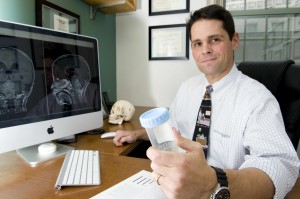 A urine sample can tell you many things. It can reveal pregnancy, signal an infection or unmask drug use. Could it also tell you about brain tumors? Maybe.
A urine sample can tell you many things. It can reveal pregnancy, signal an infection or unmask drug use. Could it also tell you about brain tumors? Maybe.
Current image-based screening for brain tumors and other neurologic diseases is time-consuming, costly and poses some risk—especially for young children who must be sedated to hold still in the scanner. The ordeal is multiplied for children who have had brain surgery and need frequent checks for disease resurgence — especially if they don’t live close to pediatric neuroimaging facilities.
That’s why Edward Smith, director of pediatric cerebrovascular surgery at Children’s Hospital Boston, is on a quest for easily detectable biomarkers that could diagnose and assess a brain tumor’s status. Brain tumors are the most common solid cancer of childhood and, next to trauma, are the leading cause of death of children.
“Right now, every three months—when we know they have a tumor—we put kids under anesthesia, place them in a freezing cold scanner and take a study for thousands of dollars to see if there’s a growth there,” says Smith.
When Smith first came to Children’s, he attended a seminar by Marsha Moses, director of the Vascular Biology Program. Moses studies angiogenesis, the growth of new blood vessels, during cancer. Her laboratory has pioneered the use of matrix metalloproteinases (MMPs) as urine biomarkers for breast and ovarian cancer. MMPs are enzymes that help tumors eat through the dense material that surrounds cells, allowing new blood vessels to sprout.
Smith was intrigued by Moses’s idea of focusing on biomarkers in urine instead of blood. The kidneys filter many circulating proteins into urine that can’t be measured reliably in blood, since their blood levels are highly variable.
Smith approached Moses, and jumped at an offer to work in her lab. Soon after, the two came across the interesting case of an eight-year-old girl who had made a doctor visit for gastrointestinal complaints. No serious problems were found, but a routine urine test showed unusually high levels of MMPs. Since the MMP research was still ongoing, the finding wasn’t used to direct the girl’s care, although a couple of years prior she’d been successfully treated for a brain tumor.
A month after the urine test, the girl developed severe headaches and vision difficulties. In the emergency room, MRIs revealed that her brain tumor had come back, and was pressing against the major vision nerves at the base of her brain. Fortunately, neurosurgeons could remove the tumor, and her vision was saved. “She did fine, thankfully,” Smith says. “But had we been smart enough to act on that biomarker when she was not symptomatic, could we have treated this before her vision was at risk?”
In 2008, Smith and Moses reported the first panel of urinary biomarkers for brain tumors, showing that certain angiogenesis proteins (vascular endothelial growth factor, MMP-2, MMP-9 and MMP-9/neutrophil gelatinase-associated lipocalin) predicted the presence or absence of a tumor. Urine levels of these biomarkers correlated with levels in the tumor tissue, and plummeted after the tumors were surgically removed.
Smith’s team is now planning to follow patients with brain tumors for at least two to three years, from initial diagnosis well into the post-surgery recovery phase, correlating levels of specific biomarkers with findings on brain scans. A major question will be whether the biomarkers identify tumor resurgence earlier, later or at the same time as the brain scans. Another will be whether biomarkers can distinguish among different types of brain tumors.
The goal of developing urinary biomarkers isn’t to replace imaging studies, Smith says, but to decide whether a brain scan is necessary and to provide additional information. A urine test won’t allow him to tell a patient, “You have a three-centimeter right cerebellar medulloblastoma that’s starting to spread,” but it can allow him to say, “You’ve got something funny going on—we should get a scan.”
Ultimately, biomarkers could fingerprint molecular suspects to go after to destroy the tumor. “I’m interested not just in developing an early warning system, which is something we really need in neurosurgery,” Smith says, “but also in identifying potential therapeutic targets.”






